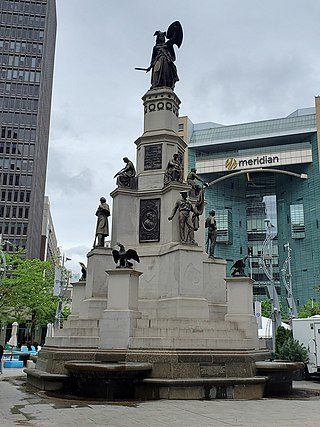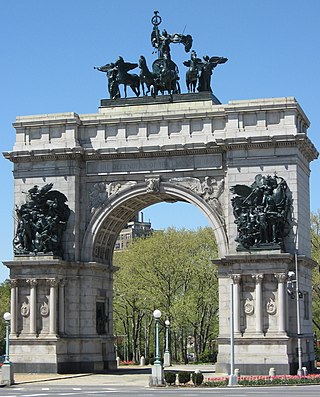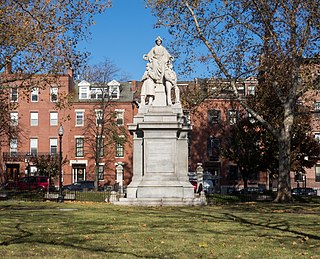
The Indiana State Soldiers and Sailors Monument is a 284 ft 6 in (86.72 m) tall neoclassical monument built on Monument Circle, a circular, brick-paved street that intersects Meridian and Market streets in the center of downtown Indianapolis, Indiana. In the years since its public dedication on May 15, 1902, the monument has become an iconic symbol of Indianapolis, the state capital of Indiana. It was added to the National Register of Historic Places on February 13, 1973 and was included in an expansion of the Indiana World War Memorial Plaza National Historic Landmark District in December 2016. It is located in the Washington Street-Monument Circle Historic District. It is also the largest outdoor memorial and the largest of its kind in Indiana.

James Edward Kelly was an American sculptor and illustrator who specialized in depicting people and events of American wars, particularly the American Civil War.

The Michigan Soldiers' and Sailors' Monument is a Civil War monument located in Downtown Detroit, Michigan. This example of civic sculpture stands in a prominent location on the southeast tip of Campus Martius Park, where five principal thoroughfares—Michigan Avenue, Monroe Street, Cadillac Square, Fort Street, and Woodward Avenue—convene on the reconstructed traffic circle in front of One Campus Martius Building. It was listed on the National Register of Historic Places in 1984.

The Monument to Nicholas I is a bronze equestrian monument of Nicholas I of Russia on St Isaac's Square in Saint Petersburg, Russia. It was created by French sculptor Auguste de Montferrand and unveiled on July 7 [O.S. June 25] , 1859, the six-meter statue was considered a technical wonder at the time of its creation. It is one of only a few bronze statues with only two support points.

Bashka Paeff, was an American sculptor active near Boston, Massachusetts.
The Attacking Cavalryman Statue in Iași, Romania is a bronze monument executed by sculptor Ion Dimitriu-Bârlad and unveiled in 1927. One of the city's signature monuments, it is located in front of the SuperCopou store, across the street from the main entrance to Copou Garden.

The Column of the Grande Armée is a 53 metre high Corinthian order triumphal column on the Rue Napoleon in Wimille, near Boulogne-sur-Mer, France.

Martin Milmore (1844–1883) was an American sculptor.

The Trenton Battle Monument is a massive column-type structure in the Battle Monument section of Trenton, Mercer County, New Jersey, United States. It commemorates the December 26, 1776, Battle of Trenton, a pivotal victory for the Continental forces and commander George Washington during the American Revolutionary War.

Oliver P. Morton and Reliefs is a public artwork by Austrian artist Rudolph Schwarz, located on the east side of the Indiana Statehouse in Indianapolis, Indiana, at the intersection of North Capitol Avenue and West Market Street.

The Pennsylvania State Memorial is a monument in Gettysburg National Military Park that commemorates the 34,530 Pennsylvania soldiers who fought in the July 1 to 3, 1863 Battle of Gettysburg during the American Civil War. The memorial stands along Cemetery Ridge, the Union battle line on July 2, 1863. Completed in 1914, it is the largest of the state monuments on the Gettysburg Battlefield.

The Soldiers' and Sailors' Arch is a triumphal arch at Grand Army Plaza in Brooklyn, New York City, just north of Prospect Park. Built from 1889 to 1892, the arch is dedicated "To the Defenders of the Union, 1861–1865".

The Memorial to Robert Gould Shaw and the Massachusetts Fifty-Fourth Regiment is a bronze relief sculpture by Augustus Saint-Gaudens opposite 24 Beacon Street, Boston. It depicts Colonel Robert Gould Shaw leading members of the 54th Regiment Massachusetts Volunteer Infantry as it marched down Beacon Street on May 28, 1863 to depart the city to fight in the South. The sculpture was unveiled on May 31, 1897. This is the first civic monument to pay homage to the heroism of African American soldiers.

Soldiers' Monument is an American Civil War monument on Worcester Common in Worcester, Massachusetts.

The Schiller Monument is located in central Berlin (Berlin-Mitte) on Gendarmenmarkt, in front of the flight of steps leading up to the former royal theater, today a concert hall. It honors the poet, philosopher and historian Friedrich Schiller, who is also regarded as one of the most significant dramatists and lyricists of the German language. The set of statues was executed by Reinhold Begas a prominent 19th-century German sculptor. It is a registered historic monument.

Commodore Oliver Hazard Perry Monument is a war monument in Cleveland, Ohio that commemorates Oliver Hazard Perry and his victory at the Battle of Lake Erie in the War of 1812. Erected at the center of the city's Public Square in 1860, its Perry statue by sculptor William Walcutt was Ohio's first monumental sculpture.

The Soldiers and Sailors Monument in Watertown, New York was erected in 1891 to commemorate local citizens who fought in the Civil War. The monument rests upon the former village green, which has been located there since 1805.

The Charlestown Civil War Memorial, also known as the Soldiers' and Sailors' Monument, is an outdoor granite monument and sculpture by Martin Milmore, commemorating the men of Charlestown, Boston, who fought to preserve the Union during the American Civil War. The memorial is installed in the Training Field in Charlestown, in the U.S. state of Massachusetts.

Commodore George Hamilton Perkins is a public memorial that stands on the grounds of the New Hampshire State House in Concord, New Hampshire, United States. The statue was designed by sculptor Daniel Chester French, with architect Henry Bacon designing the remainder of the public monument. It honors George H. Perkins, a New Hampshire native who had served as an officer in the United States Navy during the American Civil War. The statue was dedicated in 1902.























